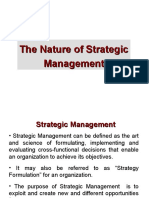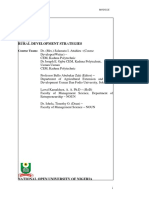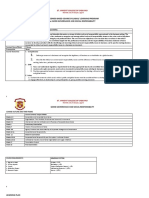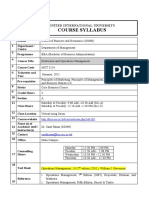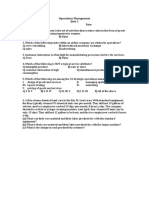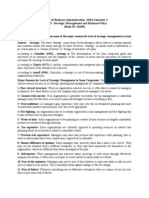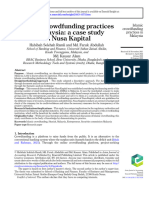0 ratings0% found this document useful (0 votes)
145 viewsDavid 14e Im 01
David 14e Im 01
Uploaded by
magibdstrategic
Copyright:
© All Rights Reserved
Available Formats
Download as DOC, PDF, TXT or read online from Scribd
David 14e Im 01
David 14e Im 01
Uploaded by
magibd0 ratings0% found this document useful (0 votes)
145 views18 pagesstrategic
Original Title
David_14e_im_01
Copyright
© © All Rights Reserved
Available Formats
DOC, PDF, TXT or read online from Scribd
Share this document
Did you find this document useful?
Is this content inappropriate?
strategic
Copyright:
© All Rights Reserved
Available Formats
Download as DOC, PDF, TXT or read online from Scribd
Download as doc, pdf, or txt
0 ratings0% found this document useful (0 votes)
145 views18 pagesDavid 14e Im 01
David 14e Im 01
Uploaded by
magibdstrategic
Copyright:
© All Rights Reserved
Available Formats
Download as DOC, PDF, TXT or read online from Scribd
Download as doc, pdf, or txt
You are on page 1of 18
Chapter 1: The Nature of Strategic Management
PART III
LECTURE NOTES
CHAPTER 1
THE NATURE OF STRATEGIC MANAGEMENT
CHAPTER OUTLINE
What is Strategic Management?
Key Terms in Strategic Management
The Strategic-Management Model
Benefits of Strategic Management
Why Some irms !o No Strategic "lanning
"itfalls in Strategic "lanning
#uidelines for $ffecti%e Strategic Management
Comparing Business and Military Strategy
The Cohesion Case: The Walt !isney Company - &'11
CHAPTER OBJECTIVES
(fter studying this chapter) you should *e a*le to do the follo+ing:
1, !escri*e the strategic-management process,
&, $-plain the need for integrating analysis and intuition in strategic management,
., !efine and gi%e e-amples of /ey terms in strategic management,
0, !iscuss the nature of strategy formulation) implementation) and e%aluation acti%ities,
1, !escri*e the *enefits of good strategic management,
2, !iscuss the rele%ance of Sun T3u4s The Art of War to strategic management,
5, !iscuss ho+ a firm may achie%e sustained competiti%e ad%antage,
CHAPTER OVERVIEW
Chapter 1 pro%ides an o%er%ie+ of strategic management, ( practical) integrati%e model of the
strategic-management process is introduced, Basic acti%ities and terms in strategic management
are defined) and the *enefits of strategic management are presented, This chapter also introduces
the notion of *o-ed inserts, ( *o-ed insert in each chapter sho+cases e-cellent strategic
management under harsh economic conditions,
Copyright 6 &'1. "earson $ducation) 7nc, "u*lishing as "rentice 8all
11
Chapter 1: The Nature of Strategic Management
VTN (Visit the Net): The website www.strategyclub.com, designed by Dr. Daid, !roides
strategic !lanning tools, tem!lates, lin"s, and information to hel! strategic management students
analy#e cases.
VTN (Visit the Net): The website htt!:$$www.!earsonhighered.com$daid$ !roides sam!le tests
and su!!lemental material for each cha!ter.
Excellent Strategic Management Showcased Winnebago Industries Inc.
7n &'11) Winne*ago +as recogni3ed for the tenth consecuti%e year as the nation4s top-selling
motor home manufacturer, Much of the company4s success is a result of e-cellent strategic
planning, 7n fiscal &'1') Winne*ago posted a 11& percent increase in re%enues and profits of
91',& million, !espite rising gas prices) shrin/ing consumer credit) rising ra+ material costs) and
high unemployment) Winne*ago is successfully offering ne+) inno%ati%e products,
EXTENDED CHAPTER OUTLINE WITH TEACHING TIPS
7, W8(T 7S ST:(T$#7C M(N(#$M$NT?
(, Strategic management can *e defined as the art and science of formulating) implementing)
and e%aluating cross-functional decisions that ena*le an organi3ation to achie%e its
o*;ecti%es,
1, The term strategic management is used synonymously +ith strategic planning,
&, The purpose of strategic management is to e-ploit and create ne+ and different
opportunities for tomorro+ +hile long-range planning tries to optimi3e for
tomorro+ the trends of today,
B, Stages of Strategic Management
1, The strategic-management process consists of three stages,
a, Strategy formulation includes de%eloping a %ision and mission) identifying an
organi3ation4s e-ternal opportunities and threats) determining internal strengths
and +ea/nesses) esta*lishing long-term o*;ecti%es) generating alternati%e
strategies) and choosing particular strategies to pursue,
*, Strategy implementation re<uires a firm to esta*lish annual o*;ecti%es) de%ise
policies) moti%ate employees) and allocate resources so that formulated
strategies can *e e-ecuted= strategy implementation includes de%eloping a
strategy-supporti%e culture) creating an effecti%e organi3ational structure)
redirecting mar/eting efforts) preparing *udgets) de%eloping and utili3ing
information systems) and lin/ing employee compensation to organi3ational
performance,
Copyright 6 &'1. "earson $ducation) 7nc, "u*lishing as "rentice 8all
12
Chapter 1: The Nature of Strategic Management
c, Strategy e%aluation is the final stage in strategic management, Managers
desperately need to /no+ +hen particular strategies are not +or/ing +ell=
strategy e%aluation is the primary means for o*taining this information,
&, Three fundamental strategy e%aluation acti%ities are pro%ided *elo+:
a, :e%ie+ing e-ternal and internal factors that are the *ases for current strategies
*, Measuring performance
c, Ta/ing correcti%e action
., Strategy formulation) implementation) and e%aluation acti%ities occur at three
hierarchical le%els in a large organi3ation: corporate) di%isional) and functional,
Smaller *usinesses may only ha%e the corporate and functional le%els,
C, 7ntegrating 7ntuition and (nalysis
1, The strategic-management process can *e descri*ed as an o*;ecti%e) logical)
systematic approach for ma/ing ma;or decisions in an organi3ation, 7t attempts to
organi3e <ualitati%e and <uantitati%e information in a +ay that allo+s effecti%e
decisions to *e made under conditions of uncertainty,
&, Most people recogni3e that intuition is essential to ma/ing good strategic
management decisions, 7ntuition is particularly useful for ma/ing decisions in
situations of great uncertainty or little precedent,
!, (dapting to Change
1, The strategic-management process is *ased on the *elief that organi3ations should
continually monitor internal and e-ternal e%ents and trends so that timely changes
can *e made as needed, The rate and magnitude of changes that affect
organi3ations are increasing dramatically,
&, By eliminating *oundaries and speeding the flo+ of information) e-commerce and
glo*ali3ation are transforming *usiness and society,
., The need to adapt to change leads organi3ations to /ey strategic-management
<uestions) such as) >What /ind of *usiness should +e *ecome?? >(re +e in the
right field?? >Should +e reshape our *usiness?? >What ne+ competitors are
entering our industry??
0, The 7nternet has changed the +ay +e organi3e our li%es) inha*it our homes) and
interact +ith family) friends) neigh*ors) and oursel%es, Consumers today are
floc/ing to *logs) forums) %ideo sites) and social net+or/ing sites instead of
tele%ision) radio) ne+spapers) and maga3ines,
Copyright 6 &'1. "earson $ducation) 7nc, "u*lishing as "rentice 8all
15
Chapter 1: The Nature of Strategic Management
Teaching Tip: Strategy @ Business is a maga3ine that pu*lishes articles that focus on strategic
management issues, The maga3ine) +hich contains e-cellent feature articles) is a%aila*le online at
http:AA+++,strategy-*usiness,comA,
Teaching Tip: The Business "olicy @ Strategy !i%ision of the (cademy of Management
maintains a +e*site that contains a +ide %ariety of useful information on strategic management
topics, The (cademy of Management +e*site is a%aila*le at http:AA+++,aomonline,orgAaom,asp,
The +e*site for the Business "olicy and Strategy !i%ision is a%aila*le at http:AA+++,*psdi%,orgA,
77, K$B T$:MS 7N ST:(T$#7C M(N(#$M$NT
(, Competiti%e (d%antage
1, Competiti%e ad%antage is defined as anything that a firm does especially +ell
compared to ri%al firms,
&, irms should see/ a sustained competiti%e ad%antage *y continually adapting to
changes in e-ternal trends and internal capa*ilities and e%aluating strategies that
capitali3e on those factors,
., (n increasing num*er of companies are gaining a competiti%e ad%antage *y using
the 7nternet for direct selling and for communication +ith suppliers) customers)
creditors) partners) shareholders) clients) and competitors +ho may *e dispersed
glo*ally,
B, Strategists
1, Strategists are indi%iduals +ho are most responsi*le for the success or failure of an
organi3ation,
&, Strategists hold %arious ;o* titles) such as chief e-ecuti%e officers) president) o+ner)
chair of the *oard) e-ecuti%e director) chancellor) dean) or entrepreneur,
., Strategists help an organi3ation gather) analy3e) and organi3e information, They trac/
industry and competiti%e trends) de%elop forecasting models and scenario analyses)
e%aluate corporate and di%isional performance) spot emerging mar/et opportunities)
identify *usiness threats) and de%elop creati%e action plans,
C, Cision and Mission Statements
1, Cision statements ans+er the <uestion: >What do +e +ant to *ecome??
&, Mission statements are >enduring statements of purpose that distinguish one
*usiness from other similar firms, ( mission statement identifies the scope of a
firm4s operations in product and mar/et terms,? 7t addresses the *asic <uestion that
Copyright 6 &'1. "earson $ducation) 7nc, "u*lishing as "rentice 8all
1D
Chapter 1: The Nature of Strategic Management
faces all strategists: >What is our *usiness?? 7t should include the %alues and
priorities of an organi3ation,
!, $-ternal Epportunities and Threats
1, $-ternal opportunities and e-ternal threats refer to economic) social) cultural)
demographic) en%ironmental) political) legal) go%ernmental) technological) and
competiti%e trends and e%ents that could significantly *enefit or harm an
organi3ation in the future,
&, Epportunities and threats are largely *eyond the control of a single organi3ation)
thus the term e%ternal,
., To sur%i%e in a glo*al economic recession) firms must *e a+are of the ne+
opportunities and threats that ha%e surfaced as a result,
0, ( *asic tenet of strategic management is that firms need to formulate strategies to
ta/e ad%antage of e-ternal opportunities and to a%oid or reduce the impact of
e-ternal threats,
1, The process of conducting research and gathering and assimilating e-ternal
information is called en%ironmental scanning or industry analysis,
$, 7nternal Strengths and Wea/nesses
1, 7nternal strengths and internal +ea/nesses are an organi3ation4s controlla*le
acti%ities that are performed especially +ell or poorly,
&, 7dentifying and e%aluating organi3ational strengths and +ea/nesses in the
functional areas of a *usiness is an essential strategic-management acti%ity,
., Strengths and +ea/nesses are determined relati%e to competitors and may *e
determined *y *oth performance and elements of *eing,
, Fong-Term E*;ecti%es
1, E*;ecti%es can *e defined as specific results that an organi3ation see/s to achie%e
in pursuing its *asic mission,
&, Fong term means more than one year,
., E*;ecti%es state direction) aid in e%aluation) create synergy) re%eal priorities) focus
coordination) and pro%ide a *asis for effecti%e planning) organi3ing) moti%ating and
controlling acti%ities,
0, E*;ecti%es should *e challenging) measura*le) consistent) reasona*le) and clear,
Copyright 6 &'1. "earson $ducation) 7nc, "u*lishing as "rentice 8all
1G
Chapter 1: The Nature of Strategic Management
#, Strategies
1, Strategies are the means *y +hich long-term o*;ecti%es +ill *e achie%ed, Business
strategies may include geographic e-pansion) di%ersification) ac<uisition) product
de%elopment) mar/et penetration) retrenchment) di%estiture) li<uidation) and ;oint
%enture,
&, Strategies currently *eing pursued *y S/ype) S*arro) and Target Corp,) and
Caesars $ntertainment are descri*ed in Ta*le 1-1,
8, (nnual E*;ecti%es
1, (nnual o*;ecti%es are short-term milestones that organi3ations must achie%e to
reach long-term o*;ecti%es,
&, Fi/e long-term o*;ecti%es) annual o*;ecti%es should *e measura*le) <uantitati%e)
challenging) realistic) consistent) and prioriti3ed,
7, "olicies
1, "olicies are the means *y +hich annual o*;ecti%es +ill *e achie%ed, "olicies include
guidelines) rules) and procedures esta*lished to support efforts to achie%e stated
o*;ecti%es,
&, "olicies are most often stated in terms of management) mar/eting)
financeAaccounting) productionAoperations) research and de%elopment) and
computer information systems acti%ities,
., Su*stantial research sho+s that a healthier +or/force can more effecti%ely and
efficiently implement strategies, Because smo/ing is a huge *urden on companies
+orld+ide) some firms are implementing policies to curtail smo/ing, Ta*le 1-&
gi%es a ran/ing of the countries *y percentage of people +ho smo/e,
777, T8$ ST:(T$#7C M(N(#$M$NT ME!$F
(, The Strategic Management Model is sho+n in igure 1-1,
1, The frame+or/ illustrated in igure 1-1 is a +idely accepted) comprehensi%e
model of the strategic-management process, This model does not guarantee
success) *ut it does represent a clear and practical approach for formulating)
implementing) and e%aluating strategies,
&, The strategic-management process is dynamic and continuous, ( change in any one
of the ma;or components in the model can necessitate a change in any or all of the
other components,
Copyright 6 &'1. "earson $ducation) 7nc, "u*lishing as "rentice 8all
&'
Chapter 1: The Nature of Strategic Management
VTN (Visit The Net): The website www.!lanware.org$strategy.htm&' e%!lains in detail how to
!re!are a strategic !lan and com!ares this document to a business !lan.
7C, B$N$7TS E ST:(T$#7C M(N(#$M$NT
The principle *enefit of strategic management has *een to help organi3ations formulate *etter
strategies through the use of a more systematic) logical) and rational approach to strategic choice,
Communication is a /ey to successful strategic management, The ma;or aim of the communication
process is to achie%e understanding and commitment throughout the organi3ation, 7t results in the
great *enefit of empo+erment, More and more organi3ations are decentrali3ing the strategic-
management process, igure 1-& illustrates the *enefits of engaging in strategic planning,
(, inancial Benefits
1, :esearch indicates that organi3ations using strategic-management concepts are
more profita*le and successful than those that do not,
&, 8igh-performing firms tend to do systematic planning to prepare for future
fluctuations in the e-ternal and internal en%ironments, irms +ith planning systems
more closely resem*ling strategic-management theory generally e-hi*it superior
long-term financial performance relati%e to their industries,
B, Nonfinancial Benefits
1, Besides helping firms a%oid financial demise) strategic management offers other
tangi*le *enefits) such as an enhanced a+areness of e-ternal threats) an impro%ed
understanding of competitors4 strengths) increased employee producti%ity) reduced
resistance to change) and a clearer understanding of performance-re+ard
relationships,
&, 7n addition to empo+ering managers and employees) strategic management often
*rings order and discipline to an other+ise floundering firm,
., #reenley stated that strategic management offers these *enefits:
a, 7t allo+s for identification) prioriti3ation) and e-ploitation of opportunities,
*, 7t pro%ides an o*;ecti%e %ie+ of management pro*lems,
c, 7t represents a frame+or/ for impro%ed coordination and control of acti%ities,
d, 7t minimi3es the effects of ad%erse conditions and changes,
e, 7t allo+s ma;or decisions to *etter support esta*lished o*;ecti%es,
f, 7t allo+s more effecti%e allocation of time and resources to identified
opportunities,
g, 7t allo+s fe+er resources and less time to *e de%oted to correcting erroneous
or ad hoc decisions,
h, 7t creates a frame+or/ for internal communication among personnel,
i, 7t helps integrate the *eha%ior of indi%iduals into a total effort,
Copyright 6 &'1. "earson $ducation) 7nc, "u*lishing as "rentice 8all
&1
Chapter 1: The Nature of Strategic Management
;, 7t pro%ides a *asis for clarifying indi%idual responsi*ilities,
/, 7t encourages for+ard thin/ing,
l, 7t pro%ides a cooperati%e) integrated) and enthusiastic approach to tac/ling
pro*lems and opportunities,
m, 7t encourages a fa%ora*le attitude to+ard change,
n, 7t gi%es a degree of discipline and formality to the management of a *usiness,
VTN (Visit the Net): The website www.entarga.com$strat!lan$inde%.htm !roides an e%cellent
narratie on the benefits of strategic !lanning, !itfalls in !lanning, and ste!s in doing strategic
!lanning.
C, W8B SEM$ 7:MS !E NE ST:(T$#7C "F(NN7N#
Some reasons for poor or no strategic planning are as follo+s:
Fac/ of /no+ledge or e-perience
"oor re+ard structures
ire fighting
Waste of time
Too e-pensi%e
Fa3iness
Content +ith success
ear of failure
E%erconfidence
"rior *ad e-perience
Self-interest
ear of the un/no+n
8onest difference of opinion
Suspicion
VTN (Visit the Net): The website www.mindtools.com$!lfail!l.html gies reasons many
organi#ations aoid strategic !lanning.
C7, "7T(FFS 7N ST:(T$#7C "F(NN7N#
Some pitfalls to +atch for and a%oid in strategic planning are pro%ided *elo+:
Hsing strategic planning to gain control o%er decisions and resources
!oing strategic planning only to satisfy accreditation or regulatory re<uirements
Too hastily mo%ing from mission de%elopment to strategy formulation
Copyright 6 &'1. "earson $ducation) 7nc, "u*lishing as "rentice 8all
&&
Chapter 1: The Nature of Strategic Management
ailing to communicate the plan to employees) +ho continue +or/ing in the dar/
Top managers ma/ing many intuiti%e decisions that conflict +ith the formal plan
Top managers not acti%ely supporting the strategic-planning process
ailing to use plans as a standard for measuring performance
!elegating planning to a >planner? rather than in%ol%ing all managers
ailing to in%ol%e /ey employees in all phases of planning
ailing to create a colla*orati%e climate supporti%e of change
Cie+ing planning as unnecessary or unimportant
Becoming so engrossed in current pro*lems that insufficient or no planning is done
Being so formal in planning that fle-i*ility and creati%ity are stifled
C77, #H7!$F7N$S E: $$CT7C$ ST:(T$#7C M(N(#$M$NT
(, ailure to ollo+ Certain #uidelines in "lanning Can Cause "ro*lems
1, (n integral part of strategy e%aluation must *e to e%aluate the <uality of the
strategic-management process, 7ssues such as >7s strategic management in our firm
a people process or a paper process?? should *e addressed,
&, (n important guideline for effecti%e strategic management is open-mindedness, (
+illingness to consider ne+ information) %ie+points) ideas) and possi*ilities is
essential,
., Strategic decisions re<uire trade-offs such as long-range %ersus short-range
considerations or ma-imi3ing profits %ersus increasing shareholders4 +ealth,
0, Su*;ecti%e factors such as attitudes to+ard ris/) concern for social responsi*ility)
and organi3ational culture +ill al+ays affect strategy-formulation decisions) *ut
organi3ations must remain as o*;ecti%e as possi*le,
1, Ta*le 1-. summari3es important guidelines for the strategic planning process to *e
effecti%e,
C777, CEM"(:7N# BHS7N$SS (N! M7F7T(:B ST:(T$#B
(, ( Strong Military 8eritage Hnderlies the Study of Strategic Management
1, Terms such as ob(ecties, mission, strengths) and wea"nesses +ere first formulated
to address pro*lems on the *attlefield,
&, ( fundamental difference *et+een military and *usiness strategy is that *usiness
strategy is formulated) implemented) and e%aluated +ith the assumption of
competition) +hile military strategy is *ased on an assumption of conflict,
Copyright 6 &'1. "earson $ducation) 7nc, "u*lishing as "rentice 8all
&.
Chapter 1: The Nature of Strategic Management
., The similarities *et+een military and *usiness strategy can *e seen in Sun T3u4s
The Art of War, Ta*le 1-0 pro%ides e-cerpts,
ISSUES FOR REVIEW AND DISCUSSION
1. Are strte!"# $%!e$e%t& %' strte!"# ()%%"%!& s*%+%*$+,s ter$s- E.()"%.
(ns+er: The term strategic management in this text is used
synonymously with the term strategic planning. The latter term is more
often used in the business world, whereas the former is often used in
academia. Sometimes the term strategic management is used to refer
to strategy formulation, implementation, and evaluation, with strategic
planning referring only to strategy formulation.
/. W0t re t0e t0ree st!es "% strte!"# $%!e$e%t- W0"#0 st!e "s $+re %)*t"#)-
W0"#0 re)"es $+st +% e$(+1er$e%t t+ 2e s,##ess3,)- W0"#0 re)"es $+st +% stt"st"#s-
J,st"3* *+,r %s1ers.
(ns+er: The three stages of strategic management include strategy formulation) strategy
implementation) and strategy e%aluation, Because it is the decision-ma/ing stage of strategic
management) strategy formulation is the most analytical stage, The strategy implementation stage
relies most on empo+erment to *e successful) and hinges upon managers4 a*ility to moti%ate
employees) +hich is more an art than a science, The strategy e%aluation stage relies most on
statistics) as it deals +ith re%ie+ing e-ternal and internal factors and measuring performance,
4. W0* '+ $%* 3"r$s $+5e t++ 0st")* 3r+$ 5"s"+%6$"ss"+% 'e5e)+($e%t t+ 'e5"s"%!
)ter%t"5e strte!"es-
(ns+er: irms that mo%e too hastily from %ision and mission de%elopment to de%ising alternati%e
strategies often are o%erloo/ing t+o important steps in the strategic management process:
e%aluation of internal strengths and +ea/nesses as +ell as e-ternal opportunities and threats,
7. W0* re strte!"# ()%%"%! retrets +3te% #+%',#te' 1* 3r+$ t0e 1+r8 s"te- H+1
+3te% s0+,)' 3"r$s 05e retret9 %' 10+ s0+,)' (rt"#"(te "% t0e$-
(ns+er: The rationale for periodically conducting strategic-management meetings a+ay from
the +or/ site is to encourage more creati%ity and candor from participants, #ood
communication and feed*ac/ are needed throughout the strategic-management process,
:. D"st"%!,"s0 2et1ee% )+%!;r%!e ()%%"%! %' strte!"# ()%%"%!.
Copyright 6 &'1. "earson $ducation) 7nc, "u*lishing as "rentice 8all
&0
Chapter 1: The Nature of Strategic Management
(ns+er: Fong-range planning is used to optimi3e for tomorro+ the trends of today) +hereas
strategic planning is used to e-ploit and create ne+ and different opportunities for tomorro+,
<. C+$(re #+$(%*=s strte!"# ()% 1"t0 3++t2)) te$=s !$e ()%.
(ns+er: ( strategic plan is) in essence) a company4s game plan, Iust as a foot*all team needs a
good game plan to ha%e a chance for success) a company must ha%e a good strategic plan to
compete successfully,
>. Des#r"2e t0e t0ree #t"5"t"es t0t #+$(r"se strte!* e5),t"+%.
(ns+er: The three fundamental strategy-e%aluation acti%ities are J1K re%ie+ing e-ternal and internal
factors that are the *ases for current strategies) J&K measuring performance) and J.K ta/ing
correcti%e actions,
?. H+1 "$(+rt%t '+ *+, t0"%8 2e"%! 'e(t t '(t"%! "s 3+r 2,s"%ess 3"r$s- E.()"%.
(ns+er: The strategic-management process is *ased on the *elief that organi3ations should
continually monitor internal and e-ternal e%ents and trends so that timely changes can *e made as
needed,
@. C+$(re t0e +(+ss,$ %' t,rt)e t+ t0e 1++))* $$$+t0 %' s2er t++t0 t"!er "% ter$s
+3 2e"%! 'e(t t '(t"%!.
(ns+er: Students4 ans+ers +ill %ary) *ut students are li/ely to ma/e the argument that those
species that are adept at adapting are a*le to sur%i%e) +hile those that are una*le to adapt are more
li/ely to perish and *ecome e-tinct,
1A. As #"te' "% t0e #0(ter9 E'1r' De$"%!9 3$+,s 2,s"%ess$%9 +%#e s"'9 "% G+' 1e
tr,st. A)) +t0ers 2r"%! 't.& W0t '"' De$"%! $e% "% ter$s +3 'e5e)+("%! strte!"#
()%-
(ns+er: The strategic-management process can *e descri*ed as an o*;ecti%e) logical) systematic
approach for ma/ing ma;or *usiness decisions in an organi3ation, 7t attempts to organi3e
<ualitati%e and <uantitati%e information in a +ay that allo+s effecti%e decisions to *e made under
conditions of uncertainty,
11. W0t strte!"es '+ *+, 2e)"e5e #% s5e %e1s((er #+$(%"es 3r+$ e.t"%#t"+%-
(ns+er: Students4 ans+ers +ill %ary and may dra+ from the >$-ternal Epportunities and Threats?
portion of the chapter) as +ell as Ta*le 1-1, ( potential strategic mo%e for ne+spaper companies
+ould *e to in%est in 7nternet technologies,
1/. D"st"%!,"s0 2et1ee% t0e #+%#e(ts +3 $"ss"+% %' 5"s"+%.
Copyright 6 &'1. "earson $ducation) 7nc, "u*lishing as "rentice 8all
&1
Chapter 1: The Nature of Strategic Management
(ns+er: Mission statements are >enduring statements of purpose that distinguish one *usiness from
other similar firms?, Cisions statements ans+er the <uestion >What do +e +ant to *ecome??
14. B+,r ,%"5ers"t* 0s 3"er#e #+$(et"t+rs. L"st t0ree e.ter%) +((+rt,%"t"es %' t0ree
e.ter%) t0rets t0t 3#e *+,r ,%"5ers"t*.
(ns+er: Students4 ans+ers +ill %ary and should dra+ from the >$-ternal Epportunities and
Threats? section of the chapter,
17. L"st t0ree "%ter%) stre%!t0s %' t0ree "%ter%) 1e8%esses t0t #0r#ter"Ce *+,r
,%"5ers"t*.
(ns+er: Students4 ans+ers +ill %ary and should dra+ from the >7nternal Strengths and
Wea/nesses? section of the chapter,
1:. L"st res+%s 10* +2De#t"5es re esse%t") 3+r +r!%"Ct"+%) s,##ess.
(ns+er: E*;ecti%es are essential for organi3ational success *ecause they state direction) aid in
e%aluation) create synergy) re%eal priorities) focus coordination) and pro%ide a *asis for effecti%e
planning) organi3ing) moti%ating) and controlling acti%ities,
1<. L"st 3+,r strte!"es %' 0*(+t0et"#) e.$()e +3 e#0.
(ns+er: Business strategies include geographic e-pansion) di%ersification) ac<uisition) product
de%elopment) mar/et penetration) retrenchment) di%estiture) li<uidation) and ;oint %entures,
$-amples of strategies should %ary,
1>. L"st s". #0r#ter"st"#s +3 %%,) +2De#t"5es.
(ns+er: Fi/e long-term o*;ecti%es) annual o*;ecti%es should *e measura*le) <uantitati%e)
challenging) realistic) consistent) and prioriti3ed,
1?. W0* re (+)"#"es es(e#"))* "$(+rt%t "% strte!* 3+r$,)t"+%-
(ns+er: "olicies) li/e annual o*;ecti%es) are especially important in strategy implementation
*ecause they outline an organi3ation4s e-pectations of its employees and managers, "olicies allo+
consistency and coordination +ithin and *et+een organi3ational departments,
1@. W0t "s retret& %' 10* '+ 3"r$s t8e t0e t"$e %' s(e%' t0e $+%e* t+ 05e t0ese-
(ns+er: :etreats are formal meetings conducted semiannually to discuss and update the firm4s
%isionAmission) opportunitiesAthreats) strengthsA+ea/nesses) strategies) o*;ecti%es) policies) and
performance, :etreats are commonly held off-premises to encourage more creati%ity and candor
from participants,
Copyright 6 &'1. "earson $ducation) 7nc, "u*lishing as "rentice 8all
&2
Chapter 1: The Nature of Strategic Management
/A. D"s#,ss t0e %+t"+% +3 strte!"# ()%%"%! 2e"%! $+re 3+r$) 5ers,s "%3+r$) "% %
+r!%"Ct"+%. O% 1 t+ 1A s#)e 3r+$ 3+r$) t+ "%3+r$)9 10t %,$2er 2est re(rese%ts
*+,r 5"e1 +3 t0e $+st e33e#t"5e ((r+#0- W0*-
(ns+er: ormality refers to the e-tent that participants) responsi*ilities) authority) duties) and
approach are specified, (pplication of the strategic-management process is typically more formal in
larger and +ell-esta*lished organi3ations, Smaller *usinesses tend to *e less formal, irms that
compete in comple-) rapidly changing en%ironments) such as technology companies) tend to *e
more formal in strategic planning, irms that ha%e many di%isions) products) mar/ets) and
technologies also tend to *e more formal in applying strategic-management concepts, #reater
formality in applying the strategic-management process is usually positi%ely associated +ith the
cost) comprehensi%eness) accuracy) and success of planning across all types and si3es of
organi3ations,
/1. L"st te% !,"'e)"%es 3+r $8"%! t0e strte!"#;()%%"%! (r+#ess e33e#t"5e. Arr%!e *+,r
!,"'e)"%es "% (r"+r"t"Ce' +r'er +3 "$(+rt%#e "% *+,r +("%"+%.
(ns+er: Ta*le 1-. presents 15 guidelines for the strategic-planning process to *e effecti%e:
1, 7t should *e a people process more than a paper process,
&, 7t should *e a learning process for all managers and employees,
., 7t should *e +ords supported *y num*ers rather than num*ers supported *y +ords,
0, 7t should *e simple and non-routine,
1, 7t should %ary assignments) team mem*erships) meeting formats) and e%en the planning
calendar,
2, 7t should challenge the assumptions underlying the current corporate strategy,
5, 7t should +elcome *ad ne+s,
D, 7t should +elcome open-mindedness and a spirit of in<uiry and learning,
G, 7t should not *e a *ureaucratic mechanism,
1', 7t should not *ecome ritualistic) stilted) or orchestrated,
11, 7t should not *e too formal) predicta*le) or rigid,
1&, 7t should not contain ;argon or arcane planning language,
1., 7t should not *e a formal system of control,
10, 7t should not disregard <ualitati%e information,
11, 7t should not *e controlled *y >technicians?,
12, !o not pursue too many strategies at once,
15, Continually strengthen the >good ethics is good *usiness? policy,
//. L"st 10t *+, 3ee) re t0e 3"5e $+st "$(+rt%t )ess+%s 3+r 2,s"%ess t0t #% 2e
!r%ere' 3r+$ The Art of War 2++8.
(ns+er: Both *usiness and military organi3ations must adapt to change and constantly impro%e to
*e successful, Ta*le1-0 pro%ides narrati%e e-cerpts from The Art of War) including these
e-amples:,
o War is a matter of %ital importance to the state,
o Warfare is *ased on deception,
o ( speedy %ictory is the main o*;ect in +ar,
Copyright 6 &'1. "earson $ducation) 7nc, "u*lishing as "rentice 8all
&5
Chapter 1: The Nature of Strategic Management
o #enerally) in +ar the *est policy is to ta/e a state intact= to ruin it is inferior to this,
o When ten to the enemy4s one) surround him, When fi%e times his strength) attac/ him, 7f
dou*le his strength) di%ide him, 7f e<ually matched) you may engage him +ith some good
plan, 7f +ea/er) *e capa*le of +ithdra+ing, (n if in all respects une<ual) *e capa*le of
eluding him,
o Kno+ the enemy and /no+ yourself,
o 8e +ho occupies the field of *attle first and a+aits his enemy is at ease) and he +ho comes
later to the scene and rushes into the fight is +eary,
o (naly3e the enemy4s plans so that you +ill /no+ his shortcomings as +ell as his strong
points,
o (n army should *e li/ened to +ater: Iust as flo+ing +ater a%oids the heights and hastens
to the lo+lands) so an army should a%oid strength and stri/e +ea/ness,
o 7f you decide to go into *attle) do not announce your intentions or plans,
o Hns/illed leaders +or/ out their conflicts in courtrooms and *attlefields, Brilliant
strategists rarely go to *attle or to court= they generally achie%e their o*;ecti%es through
tactical positioning +ell in ad%ance of any confrontation,
o When you do decide to challenge another company) much calculating estimating) analy3ing)
and positioning *ring triumph,
o S/illful leaders do not let a strategy inhi*it creati%e counter-mo%ement,
o When a decisi%e ad%antage is gained o%er a ri%al) s/illful leaders do not press on, They hold
their position and gi%e their ri%als the opportunity to surrender or merge,
o Brilliant strategists forge ahead +ith illusion) o*scuring the areas of ma;or confrontation) so
that opponents di%ide their forces in an attempt to defend many areas,
/4. W0t "s t0e 3,%'$e%t) '"33ere%#e 2et1ee% 2,s"%ess strte!* %' $")"tr*
strte!* "% ter$s +3 2s"# ss,$(t"+%s-
(ns+er: The fundamental difference *et+een military and *usiness strategy is that *usiness strategy
is formulated) implemented) and e%aluated +ith an assumption of competition) +hereas military
strategy is *ased on an assumption of conflict,
/7. E.()"% 10* t0e strte!"# $%!e$e%t #)ss "s +3te% "s #))e' #(st+%e
#+,rse.&
(ns+er: Business policy is commonly called a capstone course *ecause students4 ma;or
responsi*ility in this class is to use all /no+ledge gained in prior courses to chart the future
direction of different organi3ations,
/:. W0t s(e#t +3 strte!* 3+r$,)t"+% '+ *+, t0"%8 reE,"res t0e $+st t"$e-
W0*-
(ns+er: 7mportant aspects of strategy formulation include de%eloping a *usiness mission)
performing an e-ternal audit) conducting an internal audit) generating alternati%e strategies) and
choosing among alternati%e strategies, "erforming an e-ternal audit generally ta/es the most time,
or e-ample) identifying competitors4 strengths and +ea/nesses is an essential aspect of the
e-ternal audit, $ffecti%e use of the 7nternet can reduce the time re<uired for performing an e-ternal
audit,
Copyright 6 &'1. "earson $ducation) 7nc, "u*lishing as "rentice 8all
&D
Chapter 1: The Nature of Strategic Management
/<. W0* "s strte!* "$()e$e%tt"+% +3te% #+%s"'ere' t0e $+st '"33"#,)t st!e "%
t0e strte!"#;$%!e$e%t (r+#ess-
(ns+er: Strategy implementation is often considered to *e the most difficult stage in strategic
management *ecause it re<uires discipline) sacrifice) commitment) and hard +or/ from all
employees and managers, 7t is al+ays more difficult to do something than to say you4re going to do
it,
/>. W0* "s "t s+ "$(+rt%t t+ "%te!rte "%t,"t"+% %' %)*s"s "% strte!"#
$%!e$e%t-
(ns+er: Neither intuition nor analysis alone is sufficient for ma/ing good strategic decisions,
7ntuition) *ased on one4s past e-periences) ;udgment) and >gut? feelings) does not include the use of
analytical strategic-management concepts that ha%e *een de%eloped and successfully tested in the
*usiness +orld, To ignore these techni<ues that are *ased on historical learning is li/e trying to
rein%ent the +heel, 8o+e%er) no analytical tools can capture all aspects of a gi%en organi3ation4s
culture and situation, Nor can analytical tools assimilate all the su*;ecti%e information that must *e
considered in strategic management) such as personalities) emotions) %alues) *eliefs) customs) and
ethical factors, Thus) it is %ery important to integrate intuition and analysis in strategic management,
/?. E.()"% t0e "$(+rt%#e +3 5"s"+% %' $"ss"+% stte$e%t.
(ns+er: :eaching agreement on formal %ision and mission statements can greatly facilitate the
process of reaching agreement on an organi3ation4s strategies) o*;ecti%es) and policies,
Ergani3ational success depends on reasona*le agreement on these issues) so a clear mission
statement is a most important strategic-management tool,
/@. D"s#,ss re)t"+%s0"(s $+%! +2De#t"5es9 strte!"es9 %' (+)"#"es.
(ns+er: Fong-term o*;ecti%es and strategies are products of strategy formulation, Short-term
JannualK o*;ecti%es and policies are products of strategy implementation, irms should translate
long-term o*;ecti%es into annual o*;ecti%es, Similarly) strategies should *e supported +ith clear
policies,
4A. W0* '+ *+, t0"%8 s+$e #0"e3 e.e#,t"5e +33"#ers 3") t+ ,se strte!"#;
$%!e$e%t ((r+#0 t+ 'e#"s"+% $8"%!-
(ns+er: Some chief e-ecuti%e officers) strategists) and organi3ations ha%e *een successful) to date)
+ithout using strategic-management concepts and techni<ues, 8o+e%er) success today is no
guarantee for success tomorro+, The *usiness +orld is *ecoming glo*al in scope= technology is
changing the nature of competition in all industries, Strategic management ena*les organi3ations to
recogni3e and adapt to change more readily, Successfully adapting to change is the /ey to sur%i%al
and prosperity, There is no good alternati%e approach to strategic management,
41. D"s#,ss t0e "$(+rt%#e +3 3ee'2#8 "% t0e strte!"#;$%!e$e%t $+'e).
Copyright 6 &'1. "earson $ducation) 7nc, "u*lishing as "rentice 8all
&G
Chapter 1: The Nature of Strategic Management
(ns+er: Note in the strategic-management model that feed*ac/ is critically important, Changes can
occur that impact all strategic-management acti%ities, eed*ac/ allo+s these changes to *e
identified and ad;ustments to *e made, eed*ac/ in the strategic-management process promotes the
creation of a climate for t+o-+ay communication and) thus) allo+s esprit de corps to *e achie%ed
in an organi3ation,
4/. H+1 #% strte!"sts 2est e%s,re t0t strte!"es 1")) 2e e33e#t"5e)*
"$()e$e%te'-
(ns+er: Strategists can *est assure that strategies formulated +ill *e effecti%ely implemented *y
in%ol%ing as many managers as possi*le in the strategy formulation process, (lso) it is important to
communicate effecti%ely +hy changes are needed,
44. G"5e % e.$()e +3 re#e%t (+)"t"#) 'e5e)+($e%t t0t #0%!e' t0e +5er))
strte!* +3 % +r!%"Ct"+%.
(ns+er: Students4 ans+ers +ill %ary, Some possi*le e-amples might include 1K the series of
federal *ailouts in &''D and &''G ha%e caused corporations to *ecome more financially
transparent) &K the economic do+nturn of &''D and &''G has caused H,S, automo*ile
companies to do+nsi3e) *ecome more efficient) and in many cases) to change their entire
*usiness models) .K the political in%estigations into the Bernard Madoff case and potential
changes for in%estment firms and indi%idual in%estors that may ha%e resulted
47. W0+ re t0e $D+r #+$(et"t+rs +3 *+,r #+))e!e +r ,%"5ers"t*- W0t re t0e"r
stre%!t0s %' 1e8%esses- W0t re t0e"r strte!"es- H+1 s,##ess3,) re t0ese "%st"t,t"+%s
#+$(re' t+ *+,r #+))e!e-
(ns+er: (ns+ers to this <uestion +ill %ary *y institution,
4:. W+,)' strte!"#;$%!e$e%t #+%#e(ts %' te#0%"E,es 2e%e3"t 3+re"!%
2,s"%esses s $,#0 s '+$est"# 3"r$s- J,st"3* *+,r %s1er.
(ns+er: The ans+er to this <uestion is yes, Many foreign *usinesses are using strategic-
management concepts and techni<ues effecti%ely, Students could loo/ in the $ngland-*ased
;ournal )ong *ange +lanning to read a*out foreign firms also *enefiting from strategic-
management ideas, (nother good foreign-*ased *usiness ;ournal that carries strategic-
management articles is the ,ournal of -anagement .tudies.
4<. W0t '+ *+, 2e)"e5e re s+$e (+te%t") ("t3))s +r r"s8s "% ,s"%! strte!"#;
$%!e$e%t ((r+#0 t+ 'e#"s"+% $8"%!-
(ns+er: There is a ris/ of too little top management support for the process, There is a ris/ of
too little in%ol%ement *y line managers and employees, There is a ris/ that top managers +ill
underestimate the importance of understanding and commitment,
Copyright 6 &'1. "earson $ducation) 7nc, "u*lishing as "rentice 8all
.'
Chapter 1: The Nature of Strategic Management
4>. I% *+,r +("%"+%9 10t "s t0e s"%!)e $D+r 2e%e3"t +3 ,s"%! strte!"#;
$%!e$e%t ((r+#0 t+ 'e#"s"+% $8"%!- J,st"3* *+,r %s1er.
(ns+er: The single ma;or *enefit is the potential for impro%ed understanding of the *usiness
and industry on the part of all managers and employees, Hnderstanding generally leads to
increased commitment) +hich) in turn) leads to creati%ity) inno%ati%eness) and o%erall
cooperati%eness, The process is more important than the plan, (lso) the strategic-management
process allo+s an organi3ation to initiate and influence) rather than ;ust respond and react to
its en%ironment, That is) it allo+s an organi3ation to *e proacti%e) rather than reacti%e) in
controlling its o+n destiny, Strategic-management concepts pro%ide an o*;ecti%e *asis for
allocating resources and for reducing internal conflicts that can arise +hen su*;ecti%ity alone is
the *asis for ma;or decisions,
4?. C+$(re 2,s"%ess strte!* %' $")"tr* strte!*.
(ns+er: (s discussed in the latter part of this chapter) *usiness and military strategy are
similar in many respects, Many of the ideas de%eloped in *usiness strategy +ere first
formulated as military strategy, Both military and *usiness organi3ations ha%e competitors, (
fundamental difference *et+een military and *usiness strategy is that *usiness strategy is
formulated) implemented) and e%aluated +ith the assumption of competition) +hile military
strategy is *ased on an assumption of conflict,
4@. W0* "s "t "$(+rt%t 3+r )) 2,s"%ess $D+rs t+ st,'* strte!"# $%!e$e%t
s"%#e $+st st,'e%ts 1")) %e5er 2e#+$e #0"e3 e.e#,t"5e +33"#er +r e5e% t+( $%!er "%
)r!e #+$(%*-
(ns+er: Strategic management ta/es place at multiple le%els +ithin an organi3ation, (lthough
most students may ne%er *ecome the C$E of a corporation) they may *ecome the >*ranch
manager? or department head of a larger firm, 7n these roles) they may *e as/ed to complete a
strategic plan for their *ranch or department, 7n addition) employees at all le%els are fre<uently
as/ed to contri*ute to the de%elopment of their firm4s strategic plan, (s a result) an
understanding of the strategic-management process is important,
7A. Des#r"2e t0e #+%te%t 5")2)e +% t0e SMCO We2 s"te t
111.strte!*#),2.#+$.
(ns+er: The SMCE +e*site pro%ides lin/s to +e*sites +ith information useful for case
analysis such as corporate +e*sites) *usiness analysis ser%ices) ne+s sites) maga3ines)
go%ernmental sites) and financial ratio analyses, 7t also pro%ides lin/s to ;o* search +e*sites)
graduate school +e*sites) and +e*sites related to strategic planning, Se%eral soft+are
pac/ages are a%aila*le for purchase on the site including a template for generating the
matrices re<uired for case analyses,
71. L"st 3+,r 3"%%#") %' 3+,r %+%3"%%#") 2e%e3"ts +3 3"r$ e%!!"%! "%
strte!"# ()%%"%!.
Copyright 6 &'1. "earson $ducation) 7nc, "u*lishing as "rentice 8all
.1
Chapter 1: The Nature of Strategic Management
(ns+er: Businesses engaging in strategic planning e-perience the follo+ing financial *enefits,
They sho+ significant impro%ement in sales) profita*ility) and producti%ity compared to firms
+ithout strategic planning acti%ities, irms using strategic planning generally e-hi*it superior
long-term financial performance relati%e to their industry and seem to ma/e more informed
decisions +ith good anticipation of *oth short and long-term conse<uences, They are also
prepared for fluctuations in their e-ternal and internal en%ironments,
7n addition to the financial *enefits) firms using strategic planning also e-perience nonfinancial
*enefits, These include an enhanced a+areness of e-ternal threats) an impro%ed understanding
of competitors4 strategies) increased employee producti%ity) reduced resistance to change) and
a clearer understanding of performance-re+ard relationships,
7/. W0* "s "t t0t 3"r$ #% s,st"% #+$(et"t"5e '5%t!e %+r$))* 3+r +%)*
)"$"te' (er"+' +3 t"$e-
(ns+er: ( firm can sustain a competiti%e ad%antage for only a certain period of time due to
ri%al firms, These competing firms +ill attempt to imitate the competiti%e ad%antage in order
to undermine the leader,
74. W0* "s "t %+t 'eE,te t+ s"$()* +2t"% #+$(et"t"5e '5%t!e-
(ns+er: Because other firms +ill constantly attempt to undermine firms +ith competiti%e
ad%antages and imitate those ad%antages) organi3ations must constantly stri%e to achie%e
sustained competiti%e ad%antage,
77. H+1 #% 3"r$ 2est #0"e5e s,st"%e' #+$(et"t"5e '5%t!e-
(ns+er: Sustained competiti%e ad%antage can *est *e achie%ed *y 1K continually adapting to
changes in e-ternal trends and e%ents and internal capa*ilities) competencies) and resources)
and *y &K effecti%ely formulating) implementing) and e%aluating strategies that capitali3e upon
those factors,
Copyright 6 &'1. "earson $ducation) 7nc, "u*lishing as "rentice 8all
.&
You might also like
- Venture Design Anne Marie Knott 1Document570 pagesVenture Design Anne Marie Knott 1François AlmNo ratings yet
- Research Report On Roofing Sheets (PPGI-PPGL Corrugated Sheets) in IndiaDocument41 pagesResearch Report On Roofing Sheets (PPGI-PPGL Corrugated Sheets) in IndiaVaibhav Mathankar50% (2)
- Session Plan: CBLM On Computer System Servicing NCII Set-Up Computer Networks Document No. Issued By: Page 1 of 1Document5 pagesSession Plan: CBLM On Computer System Servicing NCII Set-Up Computer Networks Document No. Issued By: Page 1 of 1Joel CoraldeNo ratings yet
- CB Primer GSDocument141 pagesCB Primer GSsiddharth_bhargav_10100% (1)
- Threats of New Entrants: Porter's Five ForcesDocument26 pagesThreats of New Entrants: Porter's Five Forcesranaju ventiNo ratings yet
- Case Study PDFDocument3 pagesCase Study PDFLinh Bảo Bảo100% (1)
- Basic Accounting AssignmentDocument8 pagesBasic Accounting AssignmentRj Bengil70% (20)
- History of The OrganizationDocument20 pagesHistory of The OrganizationPushpa BaruaNo ratings yet
- Strategic Management SummaryDocument18 pagesStrategic Management SummaryLyra MarquezNo ratings yet
- 1st Chapter - Introduction To Strategic ManagementDocument25 pages1st Chapter - Introduction To Strategic ManagementCláudio Henrique CHNo ratings yet
- Introduction To Strategic Management: Chapter 1: What Is Strategy?Document23 pagesIntroduction To Strategic Management: Chapter 1: What Is Strategy?sarmithaNo ratings yet
- Topic 2 - Innovation in Content and Sources of InnovationDocument55 pagesTopic 2 - Innovation in Content and Sources of InnovationNile SethNo ratings yet
- Project Management Organizing and StaffingDocument67 pagesProject Management Organizing and StaffingMarjorie AgustinNo ratings yet
- Chapter-Two: Competitiveness, Strategies, and Productivity in OperationsDocument63 pagesChapter-Two: Competitiveness, Strategies, and Productivity in OperationsChernet AyenewNo ratings yet
- R1906D8711022 AssignmentDocument11 pagesR1906D8711022 Assignmentjoerichlad67% (6)
- Nature of Strategic ManagementDocument41 pagesNature of Strategic ManagementNaveed AkhterNo ratings yet
- CRD 324 Rural Development Strategies - 0Document86 pagesCRD 324 Rural Development Strategies - 0Pastor-Oshatoba Femi JedidiahNo ratings yet
- Sesi 6. Organizational Culture, Structure, and DesignDocument22 pagesSesi 6. Organizational Culture, Structure, and Designjosephine ayudhitaNo ratings yet
- Chapter 1Document26 pagesChapter 1jr9prgs9vjNo ratings yet
- Outcomes-Based Course Syllabus/ Learning Program For Good Governance and Social ResponsibilityDocument8 pagesOutcomes-Based Course Syllabus/ Learning Program For Good Governance and Social ResponsibilityLeslie Ann Elazegui Untalan100% (1)
- Course Outline - Production Operations ManagementDocument3 pagesCourse Outline - Production Operations Managementmehnoor ziaNo ratings yet
- Ab 399-Case Study Course Overview: Clodualdo V. VelascoDocument23 pagesAb 399-Case Study Course Overview: Clodualdo V. VelascoFrancis Dave Peralta BitongNo ratings yet
- Business Environment Chapter 5Document5 pagesBusiness Environment Chapter 5Muneeb SadaNo ratings yet
- 4th Year Course OutlineDocument18 pages4th Year Course OutlineEbsa AdemeNo ratings yet
- Lecture 1 Overview of Organization TheoryDocument33 pagesLecture 1 Overview of Organization TheoryAyaz DawoodNo ratings yet
- Group 1Document50 pagesGroup 1Nick Jose100% (1)
- 1 - Syllabus of HRMDocument2 pages1 - Syllabus of HRMmeiske claudia100% (1)
- Preliminary Pages - ThesisDocument14 pagesPreliminary Pages - ThesisKingdom HeartsNo ratings yet
- Organization TheoryDocument131 pagesOrganization TheoryElii ManNo ratings yet
- Module 7 in Operation ManagementDocument12 pagesModule 7 in Operation ManagementMaricar Tan ArtuzNo ratings yet
- Stratergic ManagmentDocument15 pagesStratergic Managmentamit80% (5)
- ME Module 1Document104 pagesME Module 1vinod kumarNo ratings yet
- Chapter-5 Organizational SturctureDocument35 pagesChapter-5 Organizational SturcturenoorNo ratings yet
- Perception: Prepared byDocument26 pagesPerception: Prepared byShashank GodavartyNo ratings yet
- David TIF Ch07Document14 pagesDavid TIF Ch07harlloveNo ratings yet
- Unit 4 Project Management 4Document13 pagesUnit 4 Project Management 4chuchuNo ratings yet
- Group 1 Environmental AnalysisDocument37 pagesGroup 1 Environmental AnalysisMailos JustinNo ratings yet
- Adisu's Monitoring and Evalaution Article ReviewDocument5 pagesAdisu's Monitoring and Evalaution Article ReviewAbdisen TeferaNo ratings yet
- College of Agriculture and ForestryDocument17 pagesCollege of Agriculture and ForestryJoann JacobNo ratings yet
- Test Bank For Small Business An Entrepreneurs Business Plan 9th Edition Hiduke and Ryan 1285169956 9781285169958Document7 pagesTest Bank For Small Business An Entrepreneurs Business Plan 9th Edition Hiduke and Ryan 1285169956 9781285169958joannNo ratings yet
- Topic 1 - Understand Innovation and Its ImportanceDocument41 pagesTopic 1 - Understand Innovation and Its ImportanceNile SethNo ratings yet
- David TIF CompTest 1-5Document12 pagesDavid TIF CompTest 1-5Zumrat Hossain SajanNo ratings yet
- Chapter 1 - An Introduction To International MarketingDocument24 pagesChapter 1 - An Introduction To International Marketingkingsley okohNo ratings yet
- Topic 1. Introduction To MIS FinalDocument11 pagesTopic 1. Introduction To MIS FinalMilka ThuoNo ratings yet
- Unit 5: Environmental Analysis and AppraisalDocument25 pagesUnit 5: Environmental Analysis and AppraisalSimran ManujaNo ratings yet
- Management - Group Dynamics Lecture NotesDocument19 pagesManagement - Group Dynamics Lecture Notesweirdwolfvortex0% (2)
- CH 1 Strategic MGMT OveviewDocument28 pagesCH 1 Strategic MGMT Oveviewtemesgen yohannesNo ratings yet
- Introduction To Operations Management: True / False QuestionsDocument19 pagesIntroduction To Operations Management: True / False Questionsgenc221100% (1)
- Operation ManagementDocument34 pagesOperation ManagementAyushNo ratings yet
- Chap1 Final - NoDocument138 pagesChap1 Final - NoShivam JadhavNo ratings yet
- Institute of Leadership and Good GovernanceDocument55 pagesInstitute of Leadership and Good Governanceseid negashNo ratings yet
- Business Research Methods Unit 1Document26 pagesBusiness Research Methods Unit 1pooja gupta100% (1)
- POM - Question BankDocument2 pagesPOM - Question BankDarshan PandyaNo ratings yet
- Operations Management QuizDocument1 pageOperations Management Quizjaykhan85No ratings yet
- Business Management by Juraz 85712Document53 pagesBusiness Management by Juraz 85712Munavvir PNo ratings yet
- Operations Management A Research OverviewDocument65 pagesOperations Management A Research OverviewNguyễn Trần Hoàng100% (1)
- 122 - MG8591, MG6851 Principles of Management POM - Notes 1Document136 pages122 - MG8591, MG6851 Principles of Management POM - Notes 1sharon sylvia .sNo ratings yet
- Principles of Management-SyllabusDocument1 pagePrinciples of Management-SyllabusPalani ArunachalamNo ratings yet
- Value Chain Management Capability A Complete Guide - 2020 EditionFrom EverandValue Chain Management Capability A Complete Guide - 2020 EditionNo ratings yet
- Strategic Management-Unit: 1 Definition - Strategic ManagementDocument14 pagesStrategic Management-Unit: 1 Definition - Strategic ManagementKp PrakashNo ratings yet
- Master of Business Administration-MBA Semester 4 MB0052 - Strategic Management and Business Policy (Book ID:)Document7 pagesMaster of Business Administration-MBA Semester 4 MB0052 - Strategic Management and Business Policy (Book ID:)Robins SaxenaNo ratings yet
- Chapter 8 Strategic ManagementDocument5 pagesChapter 8 Strategic ManagementVijendra GopaNo ratings yet
- Zica - Strategic Management Papaer 3.6Document120 pagesZica - Strategic Management Papaer 3.6Kabutu ChuungaNo ratings yet
- Chapter ObjectivesDocument16 pagesChapter ObjectivesDipendra ShresthaNo ratings yet
- Template Mkt5000 Marketing AuditDocument8 pagesTemplate Mkt5000 Marketing AuditterrancekuNo ratings yet
- O1-Introduction To Strategic Management: What Do You Mean by Strategy?Document7 pagesO1-Introduction To Strategic Management: What Do You Mean by Strategy?utkarsh44No ratings yet
- Recruitment of Life Advisors in Indian Life Insurance IndustryDocument92 pagesRecruitment of Life Advisors in Indian Life Insurance IndustryDeepak Sharma100% (1)
- Section 73 - Prohibition On Acceptance of Deposits From PublicDocument2 pagesSection 73 - Prohibition On Acceptance of Deposits From PublicShruti GargNo ratings yet
- Shengsiong 1rijurajDocument7 pagesShengsiong 1rijurajSibi StephanNo ratings yet
- How Do Banks Use Supply and Demand MethodDocument5 pagesHow Do Banks Use Supply and Demand MethodKalmunai TV100% (1)
- Fpo Business Plan FinalDocument63 pagesFpo Business Plan FinalkurinjimalaifpcNo ratings yet
- BSBCRT611 Brief Outline - MEGADocument2 pagesBSBCRT611 Brief Outline - MEGAKathleen Kaye CastilloNo ratings yet
- Transforming Tomorrow: 2018 Corporate Responsibility ReportDocument24 pagesTransforming Tomorrow: 2018 Corporate Responsibility ReportVishalNo ratings yet
- W.N.I. Abeygunawardana - 621438631Document10 pagesW.N.I. Abeygunawardana - 621438631AnujanNo ratings yet
- India Bangladesh RelationshipDocument4 pagesIndia Bangladesh RelationshipKorom ChandNo ratings yet
- Intangible Assets: Activities That Had Been Issued in July 1978Document3 pagesIntangible Assets: Activities That Had Been Issued in July 1978Latte MacchiatoNo ratings yet
- Qvolta QVT Whitepaper 2018Document27 pagesQvolta QVT Whitepaper 2018ryanNo ratings yet
- The Practice of Basic HR Functions in Garments Industry inDocument14 pagesThe Practice of Basic HR Functions in Garments Industry inMizanur Rahman EmonNo ratings yet
- Master M.1.CHI - Data Connectivity - Technical Specification (v01.05)Document57 pagesMaster M.1.CHI - Data Connectivity - Technical Specification (v01.05)Claudia A. Morales MelladoNo ratings yet
- Tata Neu Plus OnePager 10aug22Document2 pagesTata Neu Plus OnePager 10aug22Bollywood ForeverNo ratings yet
- School To Work TransitionDocument57 pagesSchool To Work Transitionslipi14No ratings yet
- Marketing MCQ From DR CSKDocument7 pagesMarketing MCQ From DR CSKBala ThandayuthamNo ratings yet
- Islamic Crowdfunding Practices in Malaysia: A Case Study On Nusa KapitalDocument12 pagesIslamic Crowdfunding Practices in Malaysia: A Case Study On Nusa KapitalHabibah S RamliNo ratings yet
- Oil and Gas Field Project Economics (Scribd)Document18 pagesOil and Gas Field Project Economics (Scribd)Ridha ArisNo ratings yet
- Vijaya Bank - OkokDocument78 pagesVijaya Bank - OkokSubramanya DgNo ratings yet
- Fact-Sheet SyngeneDocument4 pagesFact-Sheet SyngeneRahul SharmaNo ratings yet
- "Economies of Scale in Container Ship CostsDocument25 pages"Economies of Scale in Container Ship Costsfabrice nzepangNo ratings yet
- Part II Workout Question: - Possible Rate of Return ProbabilityDocument4 pagesPart II Workout Question: - Possible Rate of Return ProbabilitySamuel Debebe100% (4)
- The Harry Markowitz ModelDocument2 pagesThe Harry Markowitz ModelShahbaz JaffriNo ratings yet
- Strategic - Management - Marathon - Revision NotesDocument40 pagesStrategic - Management - Marathon - Revision NotesAshmi UpadhyayNo ratings yet















